Chapter 11: UAS Weapons
Student Learning Objective
The student will gain knowledge of UAS weapons, both lethal and non-lethal options, and the current state of industry and planning and execution considerations for weapons employment. The student will examine how world events are driving the UAS weapons industry as well as a glimpse at the future of weapons for UAS platforms.
History
Unmanned vehicles have been around for quite some time. Some were even weapons in and of themselves. The first consistent use of a UAS, or RPV as they were called then, was in Vietnam. The Lightning Bug program using the BQM-34 Firebee was equipped with both gravity weapons and missiles. “The Navy, meanwhile, canceled the most extensive armed UAV (unmanned aerial vehicle) program in U.S. history the same year the armed Firebee was tested, retiring its QH-50 DASH drone helicopter, which carried torpedoes and even nuclear depth bombs that were never used in combat.” (Whittle, 2015).
The Firebee underwent weapons testing late in the war. The only “weapon” used during the war was the leaflet bombs. The Firebee weapon set included MK-82 varieties that included early laser-guided bombs, early maverick missiles, early cluster bombs, TV guided weapons and unattended sensors. The BQM-34 series with various designations flew over 3,500 missions (Northrup Grumman Brochure) in Vietnam. See Figure 11-1. Most were reconnaissance, but a considerable number were decoy missions to address the enemy’s surface to air missile systems. “Despite the drone successfully destroying various mock enemies on the ground, the Air Force lost interest in the project. For one, after the Vietnam War formally ended in 1973, Washington slashed defense spending across the board.” (Joseph, 2016).
Figure 11- 1 BGM-34b
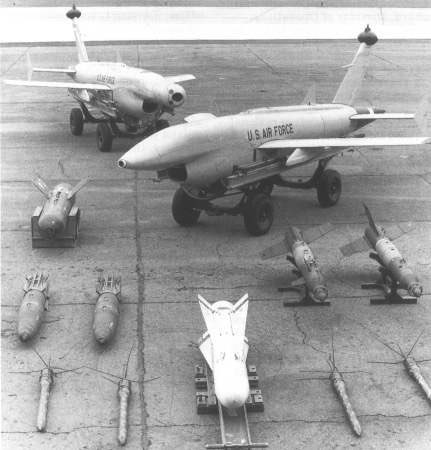
Source: Parsch, A. (2003). Teledyne Ryan AQM/BQM/MQM-34 Firebee. Retrieved From http://www.designation-systems.net/dusrm/m-34.html#_BGM (Photo By Bud Wolford)
Desert Storm: Though UASs were used to excellent effect during Desert Storm, other than cruise missiles, and armed UAS were not used.
Events in 2000
“The first predator flight over Afghanistan was on September 7th, 2000.” (Kaplan, 2016) “An unmanned spy plane called the Predator begins flying over Afghanistan, showing incomparably detailed real-time video and photographs of the movements of what appears to be Bin Laden and his aides. It flies successfully over Afghanistan sixteen times” (9-11 Commission Report, 2004). “The Predator has been used in the Balkans and Iraq since 1996. President Clinton is impressed by a two-minute video of Bin Laden crossing a street heading toward a mosque inside his Tarnak Farms complex. Bin Laden is surrounded by a team of a dozen armed men creating a professional forward security perimeter. One Predator crashes on takeoff and another is chased by a fighter, but it apparently identifies Bin Laden on three occasions. Its use is halted in Afghanistan after a few trials, as seasonal winds are picking up. It is agreed to resume the flights in the spring, but the Predator fails to fly over Afghanistan again until after 9/11” (Derek, 2000). (Kaplan, 2016)
“The USAF BIG SAFARI program office managed the Predator program and was given direction on 21 June 2000 to explore options to arm the aircraft. This led to it being fitted with reinforced wings and stores pylons to carry munitions, as well as a laser designator. The RQ-1 conducted its first firing of a Hellfire anti-tank missile on 16 February 2001, over a bombing range near Indian Springs Air Force Station north of Las Vegas, Nevada. An inert AGM-114C successfully hit a tank target. This led to a series of tests on 21 February 2001 in which the Predator fired three Hellfire missiles, scoring hits on a stationary tank with all three missiles. Following the February tests, the decision was made to move immediately to increment two of the testing phase, which involved more complex tests to hunt for simulated moving targets from greater altitudes with the more advanced AGM-114K version.” (Derek, 2000).
Figure 11-2 MQ-1 In The Smithsonian
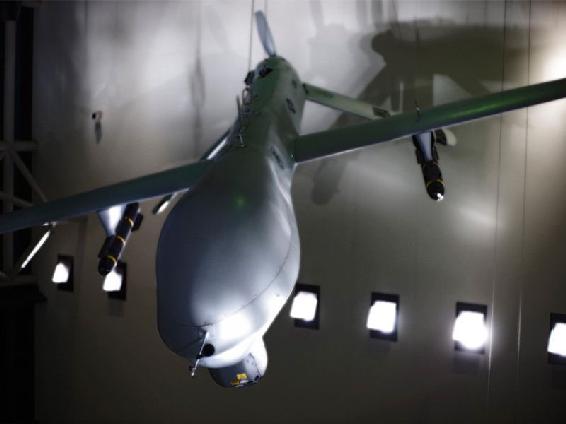
Source: Bowden, M. (Nov. 2013) In Smithsonian Magazine, https://www.smithsonianmag.com/history/how-the-predator-drone-changed-the-character-of-war-3794671
Post 9/11/2001
War on Terror: In a much-accelerated program, the Predator UAS was pressed into service with weapons. The designation for the weaponized version became the MQ-1. See Figure 11-2. Predators had been flying surveillance missions up until that point. Predators were armed with Hellfire missiles. Soon they were flying over Afghanistan. Dull, dirty, and dangerous are often cited as the reasons for unmanned vehicles, especially armed UAS. However, the driving force behind the proliferation of armed UAS in the war on terror has been shortening the kill chain and persistence in the target area. “Subsequent to 9/11, approval was quickly granted to ship the missiles, and the Predator aircraft and missiles reached their overseas location on 16 September 2001. The first mission was flown over Kabul and Kandahar on 18 September without a weapons payload. Subsequent host nation approval was granted on 7 October, and the first armed mission was flown on the same day.” (Derek, 2000). “The one pictured here was deployed in Afghanistan, where it became the first drone to fire Hellfire’s in combat. In all, it flew 261 sorties in Afghanistan, totaling more than 2,700 hours, before the Air Force donated it to the Air and Space Museum in 2003.” (Bodwden, 2013).
The combination of persistence and weapons capability turned out to be very effective. “And yet the most important breakthrough was still to come. The original drones broadcast a view only to operators on the ground. As the United States continued to fight in Afghanistan and Iraq, the drones’ cameras and sensors were linked to the global telecommunications system. Now a drone could be piloted—and its live feed viewed and its missiles aimed—from anywhere in the world. The pilots could be insulated from the risks of combat” (Bodwden, 2013).
The U.S. military quickly mounted “caps,” or permanent observation platforms, over large areas. Using computers to analyze data feeding continuously from drones, military and spy agencies isolated and tracked targets night and day. Whole enemy networks could be mapped simply by following a target’s moves and contacts over time, tying together visual imagery with other kinds of intelligence; intercepted phone calls, e-mails, and text messages. Munitions could be fired at the time and place of a drone operator’s choosing (Bodwden, 2013).
“An Iraqi MiG-25 shot down a Predator performing reconnaissance over the no-fly zone in Iraq on 23 December 2002. This was the first time in history a conventional aircraft and a drone had engaged each other in combat. Predators had been armed with AIM-92 Stinger air-to-air missiles and were being used to “bait” Iraqi fighters, then run. In this incident, the Predator did not run but instead fired one of its Stingers. The Stinger’s heat-seeker became “distracted” by the MiG’s missile and missed the MiG. The Predator was hit by the MiG’s missile and destroyed.” (Knights, 2005). This became the first air-to-air engagement by an armed UAS.
Figure 11-3 MQ-9 Reaper
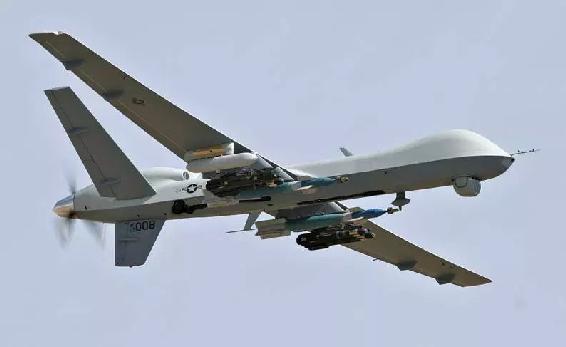
Source: Twisted Sifter. (2010) The World’s Deadliest Drone: MQ-9 Reaper. Retrieved From https://twistedsifter.com/2010/05/worlds-deadliest-drone-mq-9-reaper/
In 2007 the Predator was joined in Afghanistan by the Predator B which later was renamed as the Reaper and designated as the MQ-9. “The MQ-9 is fitted with six stores pylons. The inner stores pylons can carry a maximum of 1,500 pounds (680 kg) each and allow carriage of external fuel tanks. The mid-wing stores pylons can carry a maximum of 600 pounds (270 kg) each, while the outer stores pylons can carry a maximum of 200 pounds (91 kg) each. An MQ-9 with two 1,000 pound (450 kg) external fuel tanks and one thousand pound of munitions, has an endurance of 42 hours. The Reaper has an endurance of fourteen hours when fully loaded with munitions. The MQ-9 carries a variety of weapons including the GBU-12 Paveway II laser-guided bomb, the AGM-114 Hellfire II air-to-ground missiles, the AIM-9 Sidewinder[16], and the GBU-38 JDAM (Joint Direct Attack Munition).” (Grier, 2009). The JDAM weapon was added to the list in 2017.
“The pilots first conducted combat missions in Iraq and Afghanistan in the summer of 2007. On 28 October 2007, the Air Force Times reported an MQ-9 had achieved its first “kill,” successfully firing a Hellfire missile against Afghanistan insurgents in the Deh Rawood region of the mountainous Oruzgan province. See Figure 11-3. By 6 March 2008, according to USAF Lieutenant General Gary North, the Reaper had attacked sixteen targets in Afghanistan using 500 lb. (230 kg) bombs and Hellfire missiles (Tirpak, 2000).
The Reaper can carry as many as sixteen Hellfire missiles, but the typical load is as pictured with four Hellfires and two GBU-12 or GBU-38. “On 13 September 2009, positive control of an MQ-9 was lost during a combat mission over Afghanistan, after which the control-less drone started flying towards the Afghan border with Tajikistan. An F-15E Strike Eagle fired an AIM-9 missile at the drone, successfully destroying its engine. Before the drone impacted the ground, contact was reestablished with the drone, and it was flown into a mountain to destroy it. It was the first US drone to be destroyed intentionally by allied forces.” (Reichhardt, 2009). See Figure 11-4.
“On 27 June 2014, the Pentagon confirmed that a number of armed Predators had been sent to Iraq along with U.S. Special Forces following advances by the Islamic State of Iraq and the Levant. The Predators were flying thirty to forty missions a day in and around Baghdad with government permission, and intelligence was shared with Iraqi forces.” (“Unmanned aircraft Predator armed with Hellfire missiles used in Iraq to protected U.S. advisers,” 2014). Combat operations have continued into 2018 in Iraq and Syria to combat ISIS.
“During his eight years in office, Mr. Obama authorized roughly 550 drone strikes in Pakistan, Yemen, Somalia, and other nations in which the U.S. was not explicitly at war.
In just his first twelve months, Mr. Trump green-lighted at least eighty strikes in those countries and “is on pace to surpass the strike tempo of both of his predecessors, which perhaps signals a great willingness to use lethal force,” the survey says.” (Wolfgang, 2018). Operations in and around Afghanistan have also increased the number of strikes.
Figure 11-4 Typical Reaper Load Out with the Hellfire Missiles on the right and a GBU-12 on the Left

Source: Twisted Sifter (2010). The World’s Deadliest Drone: MQ-9 Reaper. Retrieved From https://twistedsifter.com/2010/05/worlds-deadliest-drone-mq-9-reaper/
Weapons Systems (Lethal)
Hellfire: The combination of the Predator/Reaper with the Hellfire missile brought the armed UAS into its own. There are several varieties of Hellfire missiles, but the weapon of choice has been the AGM 114K with the semi-active laser guidance. It is simple, accurate, and useful in a variety of environments. It is not without its limitations, which will be discussed later. “AGM-114K. One of the newest missiles in the Hellfire family, this missile features dual warheads, electro-optical countermeasure immunity, and a programmable guidance section for trajectory shaping/seeker logic changes. This missile is referred to as the Hellfire II missile. The missile is sixty four inches long and weighs one hundred pounds.” (AH-64D Longbow Hellfire Modular Missle System, 2009).
As an active emitting missile that is inertially guided and radar-assisted, “the RF Hellfire missile uses an active RF signal to detect and track targets. It emits RF energy and homes-in on the reflected RF energy. The missile is sixty nine inches long and weighs one hundred eight pounds” (AH-64D Longbow Hellfire Modular Missle System, 2009). The RF version would allow all-weather operations including launching through an under cast, but this weapon is not yet used by any UAS. It is the primary weapon of the Longbow helicopter.
“The AM-114M version was originally developed for the Navy. Its warhead is solely blast fragmentation, which is effective against boats and lightly armored vehicles.
The AGM-114N variant uses a thermobaric (“metal augmented charge”) warhead that can suck the air out of a cave, collapse a building, or produce an astoundingly large blast radius out in the open” (AH-64D Longbow Hellfire Modular Missle System, 2009).
A new AGM-114R “multi-purpose” Hellfire II is scheduled to go into production, with some guidance and navigation improvements and, “goes one step further than the K-A variant: it’s intended to work well against all three target types: armored vehicles, fortified positions, or soft/open targets. The Romeo is the mainstay of the future Hellfire fleet, used from helicopters and UAVs, until and unless Hellfire itself is supplanted by the JAGM program” (“US Hellfire Missile Orders, FY 2011-2017,” 2017).
“There are multiple kinds of HELLFIRE warheads to include a High-Explosive Anti-Tank, or HEAT, weapon and a Blast-Fragmentation explosive along with several others.
- The HEAT round uses what is called a tandem warhead with both a smaller and larger shaped charge. The idea is to achieve the initial requisite effect before detonating a larger explosion to maximize damage to the target.
- The Blast-Frag warhead is a laser-guided penetrator weapon with a hardened steel casing, incendiary pellets designed for enemy ships, bunkers, patrol boats and things like communications infrastructure, according to Army documents.
- The Metal Augmented Charge warhead improves upon the Blast-Frag weapon by adding metal fuel to the missile designed to increase the blast overpressure inside bunkers, ships, and multi-room targets.
- The Metal Augmented Charge is penetrating, laser-guided and used for attacks on bridges, air defenses, and oil rigs. The missile uses blast effects, fragmentation and overpressure to destroy targets.” (Osborn, 2017).
The HEAT warhead is primarily designed for armored targets. It can penetrate the defenses on all current tanks, including reactive armor. The K version uses a shaped charge warhead with a scored steel fragmentation sleeve for counter personnel and light skinned vehicle purposes. The frag pattern is significantly affected by the impact angle of the weapon. The steeper, the better.
“There are five basic considerations for using laser spot trackers (LSTs) or laser-guided weapons (LGWs):
- LOS must exist between the designator and the target and between the target and the LST/LGW.
- Pulse repetition frequency (PRF) codes of the laser designator and the LST/LGW must be compatible.
- The direction of attack must allow the LST/LGW to sense enough reflected laser energy from the target for the seeker to acquire and lock onto the target.
- The laser target designator must designate the target at the correct time, and for the correct length of time. If the length of time is insufficient, the seeker head could break the lock, and the flight pattern of the LGW becomes unpredictable.
- The delivery system must release the LGW within the specific LGW delivery envelope to ensure the weapon can physically reach the target.
There is an increased hazard to friendly forces when aircrews release weapons behind friendly positions. The final decision to release standoff LGWs from behind friendly positions in a CAS environment rests with the ground commander.” (Close Air Support-Joint Publication 3-09.3, 2014).
Figure 11-5 Hellfire Weapon Engagement Zone
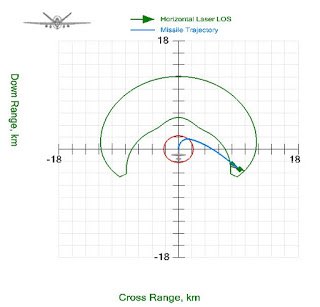
Source: Wayne, S. (2018). The Future Of Unmanned Systems. Retrieved From http://rpasarethefuture.blogspot.com/2015/11/rpa-autopilot-time-dependent-behavior.html
In open terrain this weapon, with its semi-active laser seeker, is relatively easy to employ from altitudes flown by the Reaper (Predators have been retired). However, when operations move to the more urban environment, laser operations have additional challenges. Chief among them is the ability to keep the laser spot on the target throughout the entire weapon flight time. This includes the entire slant range due to the altitude of the Reaper. Example approximate times of flight: “1 km- 3 s / 2 km- 7 s / 3 km- 10 s / 4 km- 14 s / 5 km- 19 s / 6 km- 24 s / 7 km- 29 s / 8 km- 36 s” (“Hellfire,” 2018). The aircraft’s motion during this time could place a building in the line of sight or cause part of the laser beam to reflect off a closer object or elevated terrain (hill, bridge, vehicle, etc.) The weapon guides to the first reflected laser energy. The taller the urban canyon, the more difficult it becomes.
A Hellfire launched from a Reaper at altitude has a significant WEZ (Weapon Engagement Zone) that can extend out to twelve kilometers. The weapon can also literally hit a target that is behind the wing line of the aircraft; although that zone is quite small. In Figure 11-5, the bounded green area is the projected successful WEZ. The red area reflects the weapon’s minimum range limitations, i.e., arming. The gap from the minimum range to the WEZ is a function of the altitude that the aircraft is flying. Airspeed and altitude both change the shape of the WEZ.
Although the Hellfire missile has a relatively small warhead, it still can produce a significant amount of collateral damage. Often a significant amount of time is spent waiting for non-combatants to leave the lethal zone of the missile. Sometimes the entire attack is thwarted for this reason. The typical blast/frag radius is about 15 to 20 meters.
Figure 11-6 GBU-12 Loaded On The Reaper UAS
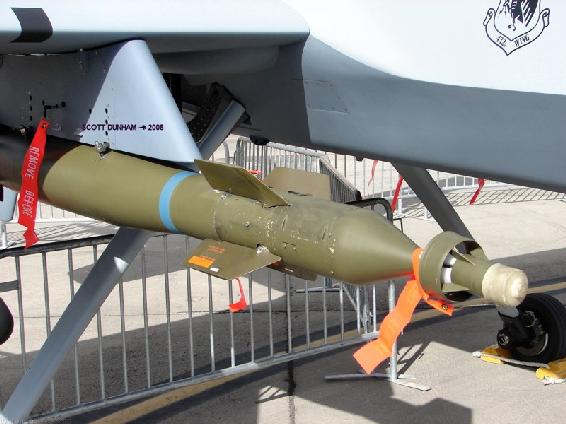
Source: Defense Talk. (2007). USAF MQ-9 Reaper GBU-12 Paveway Laser Guided Bomb, Retrieved from https://www.defencetalk.com/military/images/usaf-mq-9-reaper-gbu-12-paveway-laser-guided-bomb.32757/
a. GBU-12: “The Guided Bomb Unit-12 (GBU-12) utilizes a Mk82 500-pound general purpose warhead. The operator illuminates a target with a laser designator and then the munition guides to a spot of laser energy reflected from the target. See Figure 11-6. The GBU-12 is a member of the Paveway II series of laser-guided bombs (LGBs)” (“Guided Bomb Unit-12 (GBU-12) Paveway II,” 2017). Laser guided bombs made their debut in the Vietnam War, but rose to prominence in Operation Desert Storm. The guidance system uses a bang-bang methodology. When the weapon is no longer pointed directly at the laser, the guidance fins go to full deflection to correct the error. This generates a sinusoidal type of path about the direct line of sight. The reason this is important is twofold. First it uses up the bombs energy which starts out low due to the Reaper’s low speed at launch. Second, the bomb tends to spend more time on the low side of the direct line of sight, causing the bomb to fall short of the target in some scenarios. Techniques to overcome these effects include raising the spot location slightly on the target when possible and/or using a release point that ensures the bombs dive angle to the target is greater than 45 degrees. At that point the bomb gains energy throughout the engagement.
The GBU-12 provides a significant degree of both blast and fragmentation. See Figure 11-7.
Figure 11-7 Sample GBU-12 Delivery Envelope
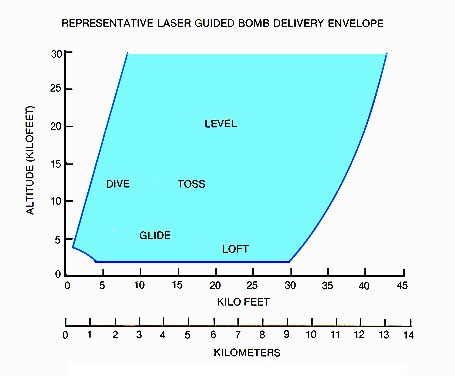
Source: Global Security. (2017) Guided Bomb Unit-12 (GBU-12) Paveway II. Retrieved from https://www.globalsecurity.org/military/systems/munitions/gbu-12.htm
The weapon can destroy a wide variety of targets. Certain targets, like tanks, require a direct hit or a coupling effect from the blast to be effective. A miss distance of ten feet or less can produce the desired coupling effect. The GBU-12 is affected by the same laser limitations in urban terrain as the Hellfire, but more pronounced. Because of the collateral damage area of the 500 lb. warhead, it is not normally the weapon of choice in populated areas for a war on terror scenario. The collateral damage radius can extend to about 2,500 ft. This effect makes the weapon ideal for groups of combatants in the open or in a building. When targeting combatants or equipment inside of a structure, a small delay fuse is incorporated into the overall fuse to ensure detonation occurs inside the structure for maximum effect. Above is an example of a Paveway II bomb delivery envelope. Actual ranges for a Reaper will generally be shorter due to the lower launch speeds of the aircraft (“Guided Bomb Unit-12 (GBU-12) Paveway II,” 2017).
Figure 11-8 GBU-38 Left And GBU-54 Right
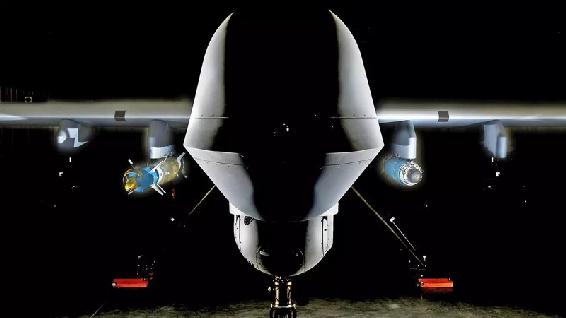
Source: Trevithick, J. S: (2017). USAF Reaper Drones Can Finally Drop GPS Guided Joint Direct Attack Munitions. Retrieved from http://www.thedrive.com/the-war-zone/10046/usaf-reaper-drones-can-finally-drop-gps-guided-joint-direct-attack-munitions
b. GBU-38/GBU-54: “The Air Force has added the Joint Direct Attack Munition (GBU-38) a GPS-guided bomb, to the Reaper drone force, dropping the first one in a combat strike in Operation Inherent Resolve…” (Clark, 2017). The weapon has the JDAM GPS/INS tail unit and a nose laser guidance unit. Operational use was started with just the tail unit and the weapon being dropped on pre-programmed coordinates. “It also has a selectable fuse….” “I can target the third floor of an apartment building, or we could target an enemy vehicle, or we could target enemy personnel in the open all with the same weapon because I know I can adjust the fuse with this weapon and I just don’t have that option with the GBU-12.” The GBU-38 is “also more useful in cloudy weather” because it uses coordinates and is not laser guided” (Clark, 2017). See Figures 11-8 and 11-9.
The GBU-54 is expected to replace the GBU-38. It also includes the JDAM tail unit and a laser guidance nose unit. Although the laser guidance unit is relatively new, it is currently scheduled to be incorporated into the overall guidance package. The GBU-54 makes it easier and more effective to take out moving targets.
Figure 11-9 MQ-9 Reaper With GBU-38 Jdams Loaded
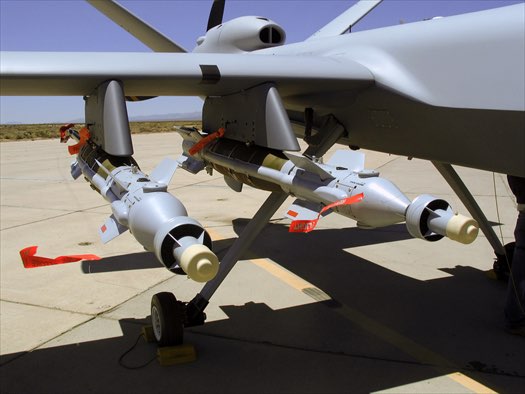
Source: Clark, C. (2017). Air Force drops first GPS bomb from Reaper: GBU-38 JDAM. Breaking defense. Retrieved from https://breakingdefense.com/2017/05/air-force-drops-first-gps-bomb-from-reaper-gbu-38-jdam/
GBU-39B/B: The Air Force has awarded a contract to General Atomics to integrate this weapon capability into its MQ-9 Reaper. Work is expected to be completed by 2021 but is already operational with the Special Operations Command. The GBU-39B/B is a laser-guided version of the small diameter bomb. The wings that deploy on release will give the Reaper a 40 nm stand-off weapons capability. The GBU-39B/B (Figure 11-10) also has INS/GPS precision guidance.
Figure 11-10 GBU-39B/B
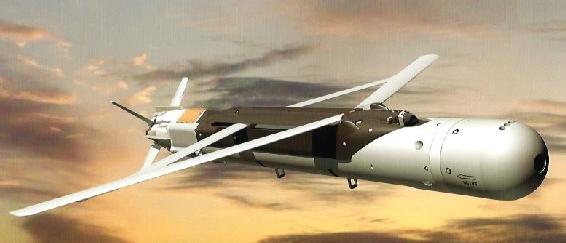
Source: Eshel, T. (2017). Drones Double Weapon Loadout with Laser-SDB. Retrieved from https://defense-update.com/20171128_lsdb.html
The choice of laser guidance or GPS guidance is a function of several considerations such as weather, laser spot size at longer ranges and whether the target is moving or stationary. “The Laser, Small Diameter Bomb variant, planned for the Reaper integrates the JDAM’s semi-active laser, enabling the bomb to hit targets moving at up to 80 km/h (50 mph) and has been fielded by the U.S. Special Operations Command since 2014” (Fergus, 2017). Because the Laser Small Diameter Bomb (LSDB) is approximately half the weight of the GBU-12/38/54 type bombs, the Reaper can double the number of precision bombs that it carries. The LSDB also has a significantly smaller collateral damage zone. Thus, making them more user-friendly in urban and near-urban environments. Since all of these weapons have a laser guidance capability, it is key that the designating aircraft or ground unit has the matching code for the weapon about to be employed. Otherwise, the weapon will not guide. Also, the different codes allow multiple weapons to be guided to separate targets by multiple aircraft or ground units.
Pulse Repetition Frequency (PRF) Codes
“Laser coding permits the simultaneous use of multiple laser designators and laser-guided weapons/seekers. Laser designators and seekers use a PRF coding system to ensure that a specific seeker and designator combination work in harmony. By setting the same code in both the designator and the seeker, the seeker tracks only the target that is designated with that code.
Code Description
The system uses either a three digit or four-digit numeral system, depending on the type of laser equipment. Three-digit settings range from 111 to 788, while four-digit settings range from 1,111 to 1,788. All three and four-digit designator/seekers are compatible. Lower numbered PRF codes provide higher quality designation due to faster pulse repetition.
Code Allocation and Assignment
Laser guided weapons system codes must be controlled and coordinated”. (JPJT, 2018) (Globalsecurity, 2016)
c. Future weapons for UAS that are smaller than the Reaper system: Several variant weapons are in design and testing phases that provide a smaller UAS with a precision weapons capability and a weapon with a much smaller collateral damage radius. Below is a chart of the current group of smaller weapons. See Table 11-1.
Table 11-1 Future Weapons (Snyder, 2018)
| Company | Weapon Name | Weight | Notes |
| MBDA | SABER | 10 lb. or 30 lb. | Glide or Rocket, GPS/INS/Laser |
| ATK | Hatchet | 6 lb. | Glide, GPS/Laser |
| ATK | Hammer | 16 lb. | Glide, Laser |
| Lockheed Martin | Shadow Hawk | 11 lb. | Glide, Laser |
| Raytheon | Griffin | 33 lb. or 45 lb. | Gravity or Rocket, GPS/INS/Laser |
| Raytheon | Pyros | 12 lb. | Gravity, GPS/INS/Laser |
| DRS | Spike (F2M2) | 5 lb. | Rocket, EO/Laser/INS |
| IAI | LAHAT | 28 lb. | Rocket, Laser |
| Thales | LMM | 28 lb. | Rocket, Laser/IR |
| Aerovironment | Switchblade | 2.2 lb. | Electric motor, EO/Data Link |
| Thales | Starstreak II | 31 lb. | Laser, 3.5 Mach |
| SAAB | BILL 2 | 23 lb. | Rocket, Wire guided |
| Lockheed Martin | Scorpion | 35 lb. | Glide, GPS/INS/Laser |
| Lockheed Martin | MHTK | 5 lb. | Semi-active radar |
| MBDA | Viper Strike | 42 lb. | Glide, GPS/Laser (Used on MQ-5) |
Weapons (Non-lethal)
Law enforcement use of UAS is still in its initial stages. However, several pilot programs and policy efforts are underway to add non-lethal weapons into the mix. Tasers and tear gas canisters are early contenders. “While no state in the US allows the use of deadly force by drones, North Dakota allows officers to equip them with stun guns and other non-lethal weapons” (Kozlowska, 2017). North Dakota police are authorized to use drones with tasers and pepper spray. The Israelis are examining stun grenades, rubber pellet grenades, coloring agent grenades, and sticky gel grenades. “The U.S. Army is seeking non-lethal warheads to be deployed on tiny UAVs; the U.S. Army describes the possible uses of the non-lethal UAV. “Potential commercial applications might include, but are not limited to: crowd control for local law enforcement; border protection for Homeland Security; or temporary incapacitation of non-violent criminals for local SWAT teams and/or law enforcement” (“U.S. military seeking non-lethal UAVs,” 2012).
The military can use these types of non-lethal weapons in certain circumstances. The battlefield, however, lends itself to addition non-lethal weapons. Also, the increased size of the unmanned military systems provides other options. Non-lethal can be further delineated by the type of target; either anti-personnel or anti-material.
Figure 11-11 Active Denial System
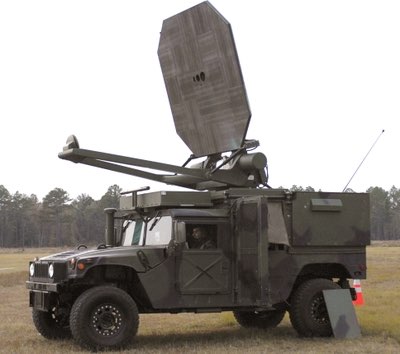
Source: Hambling, D. (2009). Pain Beam to Get Tougher, Smaller, More Powerful. Wired Hellfire. Retrieved from https://quizlet.com/26596148/hellfire-flash-cards/
Anti-personnel non-lethal weapons include chemical agents, optical weapons, acoustics, directed energy, and restraining mechanisms. Anti-material non-lethal weapons include chemical, biological, directed energy, and restraining mechanisms. See Figure 11-11.
Anti-Personnel:
Chemical Agents: “Non-lethal chemical capabilities generally include agents that induce sleep or produce irritation (calmative, neural inhibitors, irritants, and odor producing chemicals)” (Siniscalchi, 1998). These types of weapons lend themselves to small areas and favorable weather conditions
Optical Weapons: Low energy lasers directed against the eyes or night vision goggles. Flash weapons are also effective directly against personnel. Examples include flash-bang grenades and high-power strobes.
Acoustics: The two main types of acoustical weapons are the loud hailer and the low-frequency wave. The loud hailer uses directed high decibel sound to disorient, discourage and potentially disabling a target. The low-frequency system (below 50 Hz) is used to disorient or even cause nausea.
Directed Energy (High Powered Microwaves): These weapons can be dialed up or down to produce the desired effect. Additionally, certain frequencies generate specific effects. Examples include pain rays (active denial system), systems designed for nausea and disorientation or even incapacitation. At the highest settings, some of these weapons can cause permanent damage or death.
Restraining mechanisms: These are typically used to restrict operations in certain areas or protect a location, building or personnel. These include things as simple as net guns to sticky foam or super-slick liquids.
Anti-Material
Chemical/Biological: These are typically used as a more clandestine method of attacking vehicles, supplies, or infrastructure. This category includes “Supercaustic agents, derived from chemical, biological, or biological enzymes, can rapidly deteriorate rubber, plastics, or spoil petroleum supplies. These are claimed to be millions of times more caustic than hydrofluoric acid and can be delivered as a liquid or aerosol. Liquid metal embrittlement agents can alter the molecular structure of metals making them weak and susceptible to structural failure. The embrittlement agents are normally formulated for a specific metal or alloy which may complicate the flexibility that is needed for combat employment. Polymer agents are extremely strong adhesives. Polymers, called stick-ems, can be applied as a liquid or foam to deny the mobility of equipment and personnel. Alternatively, super-lubricants (slick-ems) are being developed as an anti-traction capability that could disrupt the movement of vehicles” (Siniscalchi, 1998). The target area for these kinds of weapons are typically finite but can have broader effect; such as railroad tracks, pipelines, truck parks, or supply depots. Plants are another potential target. The use of genetically engineered blights on rice, cocoa, poppies, etc. could have a very outsized effect on the conflict. Defoliants have been used with success but with very harmful side effects. New defoliants without the side effects can make a significant impact in certain regions of the world.
Directed Energy/Electromagnetic Pulse (DE /EP):
“This technology offers a significant capability against modern electronic equipment susceptible to damage by transient power surges. This weapon generates a very short, intense energy pulse producing a transient surge of thousands of volts that kills semiconductor devices. See Figure 11-12.
Figure 11-12 Counter-electronics High-powered Microwave Advanced Missile
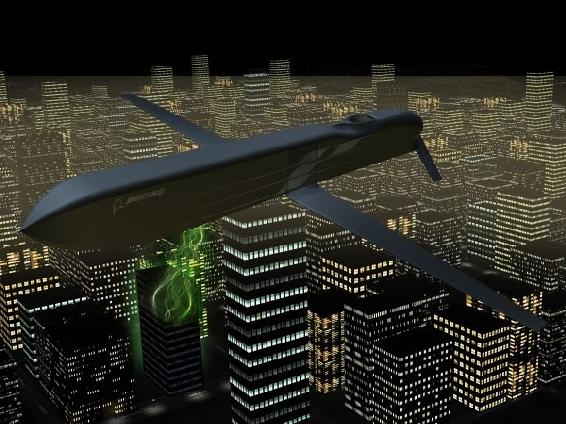
Source: Stoker, L. (2012) Electromagnetic pulse weaponry: Boeing CHAMP video and jammer grenades. Retrieved from https://www.army-technology.com/features/featureelectromagnetic-pulse-weaponry-boeing-champ-jammer-grenades
The conventional EMP and HMP weapons can disable non-shielded electronic devices including practically any modern electronic device within the effective range of the weapon. The effectiveness of an EMP device is determined by the power generated and the characteristic of the pulse. See Figure 11-13.
Figure 11-13 Portable Jammer
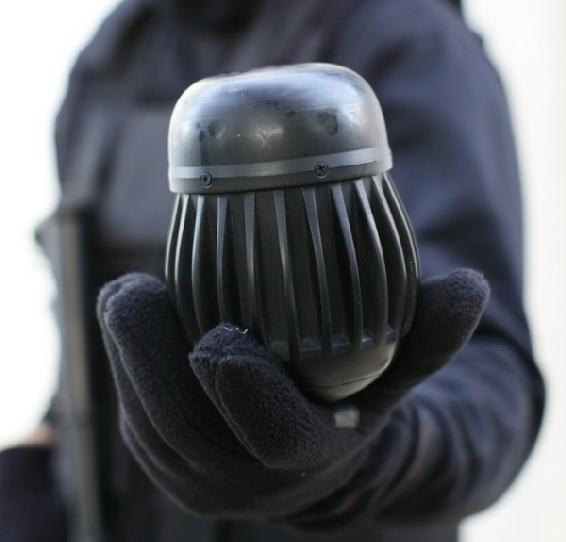
Source: Stoker, L. (2012). Electromagnetic pulse weaponry: Boeing CHAMP video and jammer grenades. Retrieved from https://www.army-technology.com/features/featureelectromagnetic-pulse-weaponry-boeing-champ-jammer-grenades
The shorter pulse waveforms, such as microwaves, are far more effective against electronic equipment and more difficult to harden against. Current efforts focus on converting the energy from an explosive munitions to supply the electromagnetic pulse. This method produces significant levels of directionally focused electromagnetic energy” (Stoker, 2012). These conventional weapons are designed to engage a finite area unlike the potential widespread effect of a high altitude nuclear weapon. Weapons in this category could target a single UAS or take down a whole electrical grid.
Restraining mechanisms: Many of these weapons are designed to stop a vehicle. The police use many of these technologies to assist with ending a pursuit without further endangering the lives of the fleeing criminals. These include Spike Strips, Grapplers, and a variety of wheel nets. Grapplers are the only ones attached to a pursuing vehicle and used to capture the wheel of the vehicle in front. Some wheel nets are designed to capture the wheels of the vehicle while anchored firmly to the ground to stop the vehicle. Other nets combine the net effect with the spike strip effect. With the proliferation of small UAS comes the advent of counter UAS weapons. A couple of those weapons use nets to capture and secure the UAS. See Figure 11-14.
Figure 11-14 Drone launches a net to capture another drone
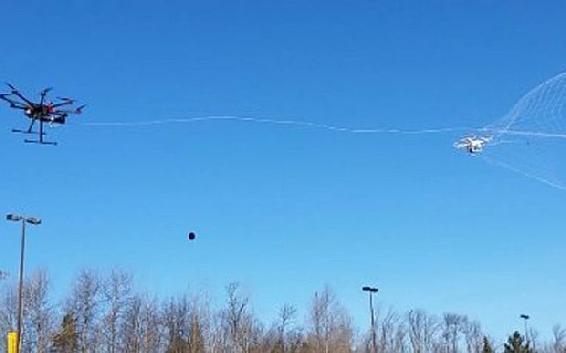
Source: Titcomb, J. (2016). This drone catches other drones by shooting nets at them. Retrieved from https://www.telegraph.co.uk/technology/news/12093204/This-drone-catches-other-drones-by-shooting-nets-at-them.html
Protecting the Weaponized Systems from the Cyber Threat/Response
- Threat: Susceptible to the enemy taking control of the UAS via the data link.
- Response: Encrypt all data links. User identifier codes.
- Threat: Susceptible to GPS denial attacks or GPS signal manipulation.
- Response: Military encrypted and directional GPS receivers such as SAASM (Selective Availability Anti-Spoofing Module).
- Threat: Susceptible to the enemy using high powered microwaves against the UAS or the weapon.
- Response: Electronic hardening and shielding efforts.
- Threat: Susceptible to the enemy manipulating the UAS head flux compass.
- Response: Low drift inertial navigation units and/or differential GPS signals.
- Threat: Susceptible to the enemy jamming the data link signal to and/or from the UAS.
- Response: Frequency hopping and other counter jamming techniques. The addition of the appropriate level of artificial intelligence (AI). A local controller that can overpower the remote jammer.
- Threat: Susceptible to the enemy waging a cyber-attack on one or more of the satellites being used to control the UAS from a remote location.
- Response: Military hardened commercial satellites.
- Threat: Susceptible to the enemy waging a cyber-attack on the controlling facility.
- Response: UAS control isolation from other information assets in the facility. Securing possible attack entry points to the control station, including power.
Conclusions
Armed UAS came into their own during the long-running war on terror, forever changing the nature of warfare. Their persistence in the target area and the ability to immediately prosecute the target has given the U.S. and its allies a significant advantage in an area of the world that historically proved very difficult for outsider militaries. This is true especially in the rugged areas of Afghanistan and surrounding countries. Unmanned aircraft are not limited by terrain. What was the enemy’s advantage in this arena has become part of their weakness. The Predator/Reaper has been the focus so far for the U.S. armed UAS effort. Initially, their only weapon was the Hellfire Missile. The advent of the Reaper UAS with its larger payload capability added the 500 lb. Laser guided bomb to the equation. The continued success of the Reaper in the war has brought it several new versions of the 500 lb. weapon. The latest version is the GBU-54, with both INS/GPS and laser guidance, handle stationary and moving targets in a variety of weather conditions. Still, the Reaper can only carry two of these precision bombs along with four Hellfire missiles. Thus, a new weapon is being added to the mix; the GBU-39B/B. At approximately half the weight of the GBU-54, the Reaper can double its bomb load to four. The GBU-39B/B also gives the Reaper a 40nm standoff range. The next major effort is the arming of smaller UAS. A significant variety of weapons have emerged as contenders for this role. All are precision weapons. Some are rocket powered. Some are gravity weapons. All produce a much smaller collateral damage radius, which is ideal for both urban and rural operations, where non-combatants could be a factor. In parallel with this development program is the advent of combining unmanned aircraft, especially smaller ones with non-lethal weapons. There is a significant amount of overlap in non-lethal weapon types between the military and law enforcement. Law enforcement has taken some of the early steps in advancing their non-lethal capabilities. Their early weapons of choice have been a type of Taser, pepper balls, tear gas and flash/bang grenades. This will give law enforcement and the military a whole new set of tools for a wide variety of mission types. One of the most significant tools for the military is likely to be the use of directed energy weapons. Though non-lethal, they can have a major impact on both personnel and material targets. Weaponized unmanned vehicles are still in its early stages, but due to their significant success so far, expect to see many more varieties in the future. Protecting these assets against the current and future cyber-attack challenges will play a major role in their continued success.
Questions
- How do world events drive the weaponization of UAS?
- What cyber factors should be considered when pairing a UAS with a specific weapons system?
- What non-lethal options could the military and lawn enforcement choose instead of lethal action in a major city?
- Do you think the armed UAS will replace manned combat and support aircraft?
- What dangers do you see in using an all armed UAS air force?
Bibliography
Globalsecurity. (2016, March 16). Laser Employment. Retrieved from Global Security Org: https://www.globalsecurity.org/military/library/policy/usmc/mcwp/3-16/fdraft_appk.pdf
JPJT. (2018, August 26). Appendix K Laser Employment. Retrieved from JPJT Army Manual: http://docplayer.net/40451907-appendix-k-laser-employment.html
Kaplan, F. (2016, September 9). a_history_of_the_armed_drone. Retrieved from Slate News: http://www.slate.com/articles/news_and_politics/the_next_20/2016/09/a_history_of_the_armed_drone.html
References
9-11 Commission Report. (2004). Retrieved from Washington DC: https://www.9-11commission.gov/report/911Report.pdf
AH-64D Longbow Hellfire Modular Missle System. (2009). Fort Rucker, Alabama: US Army Aviation Center of Excellence Retrieved from http://gomotherrucker.com/mem/fdrgifhsnu4/ah64/studenthandouts/0923LBHMMSLOT11.pdf.
Bodwden, M. (2013). How the Predator Drone Changed the Character of War. Retrieved from https://www.smithsonianmag.com/history/how-the-predator-drone-changed-the-character-of-war-3794671/#oPiV9wmC9GGYevbF.99
Clark, C. (2017). Air Force Drops First GPS Bomb From Reaper: GBU-38 JDAM. Breaking Defense. Retrieved from https://breakingdefense.com/2017/05/air-force-drops-first-gps-bomb-from-reaper-gbu-38-jdam/
Close Air Support-Joint Publication 3-09.3. (2014). Washington DC US Department of Defense Retrieved from https://fas.org/irp/doddir/dod/jp3_09_3.pdf.
Derek, M. (2000). Complete 911 Timeline US Drone Use in Pakistan or Afghanistan. Retrieved from http://www.historycommons.org/timeline.jsp?timeline=complete_911_timeline&complete_911_timeline__war_on_terrorism__outside_iraq=complete_911_timeline_pakistan___afghanistan_drone_stikes
Eshel, T. (2017). Drones Double Weapon Loadout with Laser-SDB. Retrieved from https://defense-update.com/20171128_lsdb.html
Fergus, K. (2017). General Atomics to integrate precision-guided small diameter bomb onto Reaper drone. Retrieved from https://thedefensepost.com/2017/11/28/reaper-drone-small-diameter-bomb-integration/
Grier, P. (2009). Drone aircraft in a stepped-up war in Afghanistan and Pakistan. Retrieved from https://www.csmonitor.com/USA/Military/2009/1211/Drone-aircraft-in-a-stepped-up-war-in-Afghanistan-and-Pakistan
Guided Bomb Unit-12 (GBU-12) Paveway II. (2017). Retrieved from https://www.globalsecurity.org/military/systems/munitions/gbu-12.htm
Hambling, D. (2009). Pain Beam to Get Tougher, Smaller, More Powerful. Wired
Hellfire. (2018). Retrieved from https://quizlet.com/26596148/hellfire-flash-cards/
Joseph, T. (2016). Vintage Videos Show the US Air Force’s First Armed Drone Dropping Bombs. Retrieved from https://motherboard.vice.com/en_us/article/53dkeq/vintage-videos-show-the-us-air-forces-first-armed-drone-dropping-bombs
Knights, M. (2005). Cradle of Conflict: Iraq and the Birth of Modern US Military Power. Annapolis, MD: US Naval Institute Press.
Kozlowska. (2017). Is the US ready for police drones outfitted with tasers, tear gas, and lethal weapons? Retrieved from https://qz.com/947368/police-in-connecticut-could-be-first-in-us-to-fly-drones-outfitted-with-lethal-weapons/
Osborn, K. (2017). The US is running out of Hellfire missiles because of ISIS. Business Insider.
Reichhardt, T. (2009). Robot airplane goes AWOL, gets shot down. Air & Space Magazine.
Siniscalchi, J. (1998). Non-Lethal Technologies: Implications for Military Strategy. Maxwell Air Force Base, Alabama: US Air Force Center for Strategy and Technology Retrieved from https://fas.org/man/dod-101/sys/land/docs/occppr03.htm.
Snyder, J. (2018). The Latest Tools, Techniques and Opportunities in UAV Design. In. Arlington, VA: Mongo Industries, LLC.
Stoker, L. (2012). Electromagnetic pulse weaponry: Boeing CHAMP video and jammer grenades. Retrieved from https://www.army-technology.com/features/featureelectromagnetic-pulse-weaponry-boeing-champ-jammer-grenades
Tirpak, J. A. (2000). Find, Fix, Track, Target, Engage, Assess. Retrieved from http://www.airforce-magazine.com/MagazineArchive/Pages/2000/July%202000/0700find.aspx
Titcomb, J. (2016). This drone catches other drones by shooting nets at them. Retrieved from https://www.telegraph.co.uk/technology/news/12093204/This-drone-catches-other-drones-by-shooting-nets-at-them.html
Trevithick, J. (2017). UASF Reaper Drones Can Finally Drop GPS Guided Joint Direct Attack Munitions. Retrieved from http://www.thedrive.com/the-war-zone/10046/usaf-reaper-drones-can-finally-drop-gps-guided-joint-direct-attack-munitions
U.S. military seeking non-lethal UAVs. (2012). Retrieved from http://www.homelandsecuritynewswire.com/dr20120429-u-s-military-seeking-nonlethal-uavs
Unmanned aircraft Predator armed with Hellfire missiles used in Iraq to protected U.S. advisers. (2014). Retrieved from http://www.armyrecognition.com/june_2014_global_defense_security_news_uk/unmanned_aircraft_predator_armed_with_hellfire_missiles_used_in_iraq_to_protected_u.s._advisers_2806.html
US Hellfire Missile Orders, FY 2011-2017. (2017). Retrieved from https://www.defenseindustrydaily.com/us-hellfire-missile-orders-fy-2011-2014-07019/
USAF MQ-9 Reaper GBU-12 Paveway Laser Guided Bomb. (2007). Retrieved from https://www.defencetalk.com/military/images/usaf-mq-9-reaper-gbu-12-paveway-laser-guided-bomb.32757/
Wayne, S. (2018). The Future of Unmanned Systems. Retrieved from http://rpasarethefuture.blogspot.com/2015/11/rpa-autopilot-time-dependent-behavior.html
Whittle, R. (2015). Hellfire Meets Predator. Retrieved from https://www.airspacemag.com/flight-today/hellfire-meets-predator-180953940/#bBdb2HLUkHjsZ5fK.99
Wolfgang, B. (2018). Trump outpacing Obama in drone strikes; 80 in the first year. Retrieved from https://www.washingtontimes.com/news/2018/jun/7/donald-trump-outpacing-barack-obama-drone-strikes-/
The World’s Deadliest Drone: MQ-9 REAPER. (2010). Retrieved from https://twistedsifter.com/2010/05/worlds-deadliest-drone-mq-9-reaper/

